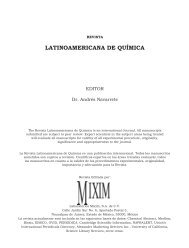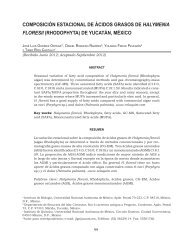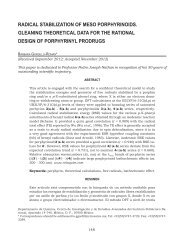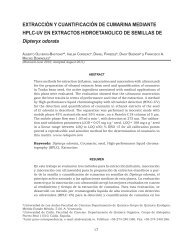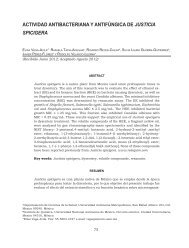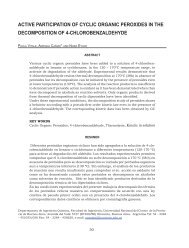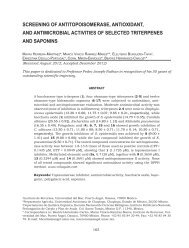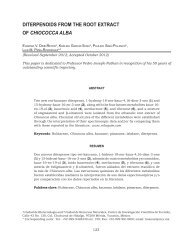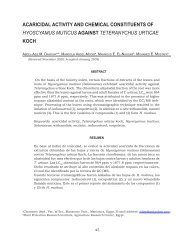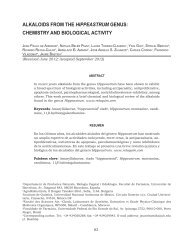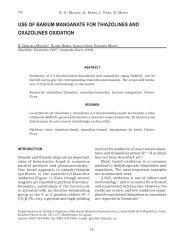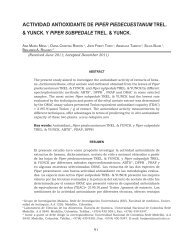POLYPHENOLS AND BIOLOGICAL ACTIVITIES OF Feijoa ...
POLYPHENOLS AND BIOLOGICAL ACTIVITIES OF Feijoa ...
POLYPHENOLS AND BIOLOGICAL ACTIVITIES OF Feijoa ...
You also want an ePaper? Increase the reach of your titles
YUMPU automatically turns print PDFs into web optimized ePapers that Google loves.
104 S.M. El-shenawy et al.<br />
INTRODUCTION<br />
<strong>Feijoa</strong> sellowiana, O. Berg (syn Acca sellowiana)<br />
is belonging to family Myrtaceae.<br />
It is native to southern Brazil, northern<br />
Argentina, western Paraguay (Trease and<br />
Evans, 1978) being traditionally known as<br />
pineapple guava. The plant is used in many<br />
industrialized products particularly in the<br />
Australian area, in the form of jams, syrups,<br />
liquors and crystallized fruits (Di. Cesare et<br />
al., 1998).<br />
F. sellowiana leaves, fruits and<br />
stems were reported to exhibit antimicrobial,<br />
antitumor, anti-inflammatory and antioxidant<br />
effects (Isobe<br />
et al., 2003; Vuotto et al.,<br />
1999). Few studies dealt with the chemistry<br />
of F. sellowiana as a flavone (Ruberto and<br />
Tringali, 2004), volatile components (Fernandez<br />
et al., 2004; Di. Cesare et al., 2000;<br />
Shaw et al., 1990), lipids (Di. Cesare et al.,<br />
1998) and tannins (Okuda et al., 1982).<br />
This study aims at the isolation and<br />
identification of the constitutive polyphenols<br />
in the aqueous methanol extract of<br />
the leaves and twigs of F. sellowiana in<br />
addition to evaluation of the analgesic,<br />
anti-inflammatory, antiulcer, antioxidant<br />
and hepatoprotective effects of the investigated<br />
extract.<br />
MATERIALS <strong>AND</strong> METHODS<br />
Equipments<br />
The NMR spectra were recorded at 300, 400<br />
and 500 ( 1 H) and 75, 100, 125 ( 13 C) MHz,<br />
on a Varian Mercury 300, Bruker APX-400<br />
and JEOL GX-500 NMR spectrometers and<br />
δ-values are reported as ppm relative to<br />
TMS in the convenient solvent. HRESI-MS<br />
analyses were run on LTQ-FT-MS spectrometer<br />
(Thermo Electron, 400, Germany). UV<br />
analyses for pure samples were recorded as<br />
MeOH solutions and with different diagnostic<br />
UV shift reagents on a Shimadzu UV 240<br />
(P/N240–58000) and Ebeckman DU7 spectrophotometer.<br />
For column chromatography,<br />
Sephadex LH-20 (Pharmacia, Uppsala,<br />
Sweden), microcrystalline cellulose (E. Merck,<br />
Darmstadt, Germany) and polyamide 6<br />
(Fluka Chemie AG, Switzerland) were used.<br />
For paper chromatography; Whatman No.<br />
1 sheets (Whatman Ltd., Maidstone, Kent,<br />
England) were used.<br />
Plant material<br />
Leaves and twigs of F. sellowiana O. Berg<br />
were collected in February 2004 and April<br />
2005 from Zohria Botanical Garden, Cairo,<br />
Egypt. The identification of the plant was<br />
performed by Dr. Amal Abdel-Aziz, Lecturer<br />
of Taxonomy, Institute of Horticulture,<br />
Zohria Botanical Garden. A voucher<br />
sample (No.: F-1) is kept in the Herbarium,<br />
Pharmacognosy Department, Faculty of<br />
Pharmacy, Helwan University.<br />
Extraction and Isolation<br />
Air-dried ground leaves and twigs (850<br />
g) were extracted with hot 80 % aqueous<br />
methanol (5L, then 4 x 4L) under reflux<br />
(80 ˚C). After evaporation of solvent under<br />
reduced pressure, the residue (60 g) was<br />
defatted with petroleum ether (60-80 ˚C)<br />
under reflux (5 x 1.5 L, 60 ˚C). The residue<br />
(40 g), after evaporation of petroleum ether<br />
was re-dissolved in pure methanol to yield<br />
29 g as dry methanol soluble portion. It was<br />
preliminary fractionated on a polyamide<br />
column (300 g, 110 x 7 cm) using a step<br />
gradient elution with H 2<br />
O-MeOH in ratio of<br />
100:0 – 0:100 giving 28 fractions of 1L each,<br />
which were collected and monitored by<br />
Comp-PC (systems S 1<br />
and S 2<br />
) and UV-light<br />
into three major collective fractions (I-III)<br />
with other non-phenolic fractions. Fraction<br />
I (3.5 g) was subjected to repeated column<br />
chromatography (CC) on microcrystalline<br />
cellulose using n-BuOH-2-propanol-H 2<br />
O<br />
BIW (4:1:5, organic layer as an eluent) followed<br />
by repeated and separately cellulose<br />
column for each major subfraction using<br />
MeOH/BIW (50 %) to give compounds 8<br />
(13 mg), 9 (25 mg) and 10 (20 mg). Fraction<br />
II (1.7 g) was chromatographed on a<br />
Sephadex C and eluted with MeOH to give



